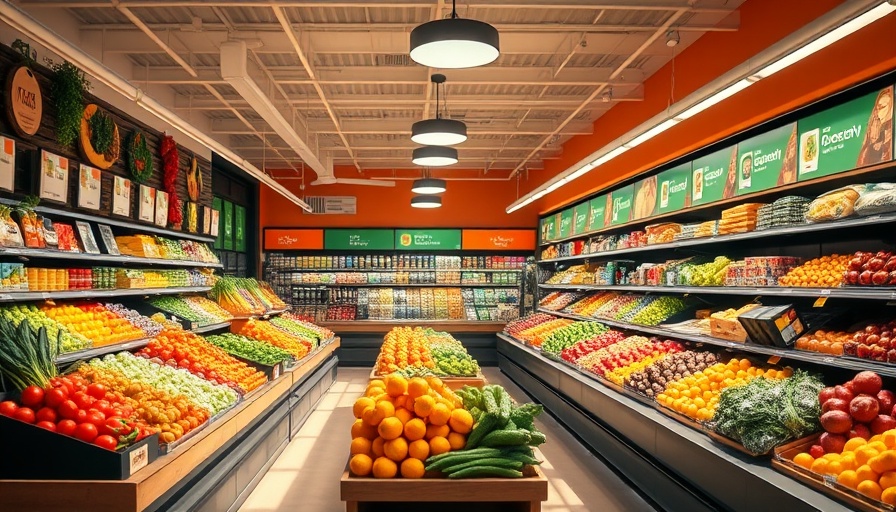
How Store Design Drives Consumer Behavior
When we think of grocery shopping, the experience often feels mundane. However, behind the scenes, grocery store owners are carefully crafting the design of their spaces to help influence consumer spending and enhance overall shopping experiences. The layout of a grocery store plays a pivotal role in determining how shoppers navigate through the aisles and the decisions they make along the way.
Grocery stores employ a sophisticated blend of psychology, marketing strategies, and education to optimize foot traffic and expenditure. According to recent studies, strategically optimized layouts can increase revenue by a remarkable 13.71%, presenting a compelling incentive for store owners to rethink their designs.
The Psychology of Your Grocery Journey
At the heart of a successful grocery layout lies the understanding of consumer psychology. A shopper’s journey begins the moment they walk through the door, and their behavior is significantly influenced by the store’s configuration. The concept is known as the "shopping journey," where the customer enters with their buying intentions, but factors such as layout, pace, and sensory cues shape their route and final purchases.
Elements like strategic zoning, the placement of high-margin products, and sensory details such as lighting and decor can subtly dictate how long consumers linger in certain areas. Creating emotional connections, particularly through visual and aesthetic elements, enhances the shopping experience, potentially leading to increased consumer spend.
Key Grocery Store Layout Models
Different layouts serve distinct purposes and respond to various consumer needs. Here are some predominant designs:
- Diagonal Layout: Utilizes angled aisles to improve visibility, making it suited for mid-sized stores aiming to engage customers more effectively.
- Free-Flow Layout: Encourages non-linear exploration, ideal for boutique markets.
- Grid Layout: This classic design maximizes product exposure with long, parallel aisles, best for traditional supermarkets.
- Herringbone Layout: Angled aisles optimize visibility, commonly used in smaller specialty stores.
- Loop (Racetrack) Layout: A guiding circuit promotes cross-department exploration and encourages browsing.
- Spine Layout: A structured central aisle branches into product zones, providing a balance of organization and flexibility.
The Role of Zoning in Store Layout
Every inch of a grocery store has the potential to generate revenue. This is where zoning comes into play. By logically grouping departments—like placing fresh produce at the entrance—stores can create vibrant impressions that appeal to the health-conscious consumer.
Optimal placements heighten the visibility of products and encourage cross-selling; for instance, putting meats near the grill supplies or beverages can spur unplanned purchases. Establishing key zones not only improves consumer navigation but also amplifies overall sales.
Future Trends in Grocery Store Design
The future of grocery store design is also evolving with technology. Smart shopping carts equipped with tracking capabilities could soon offer personalized product recommendations, leading shoppers directly to desired items, thus reducing frustration and enhancing satisfaction. As consumers become more digitally savvy, the integration of technology into traditional shopping experiences will grow, reshaping how stores design their layouts.
Understanding the Value of an Effective Store Layout
For business owners and consultants focusing on growth strategies, it is essential to understand that the implementation of strategic layouts does more than just influence spending. It can substantially improve customer retention, as satisfied shoppers are more likely to return. An engaging environment encourages word-of-mouth recommendations and can lead to an increase in footfall, presenting a competitive advantage in a crowded market.
Capturing the Right Customer Experience
The emotional experience tied to shopping cannot be understated. Shoppers often seek comfort and familiarity; a well-designed store layout can invoke these feelings while still pushing their spending limits. Retailers that understand how to dance between consumer comfort and optimized layouts are likely to see an increase in loyal customers and profits.
Next Steps for Grocery Store Owners
As grocery store layouts continue to evolve, it is critical for business owners to stay informed about consumer preferences and emerging industry trends. This means not only regularly evaluating layout effectiveness but also gathering feedback from customers to refine their shopping journey further. Connecting with customers fosters a sense of community and offers invaluable insights into their shopping patterns.
For business owners looking to enhance their grocery stores effectively, embracing innovative layouts could be the key to unlocking new levels of success.
 Add Row
Add Row  Add
Add 




Write A Comment